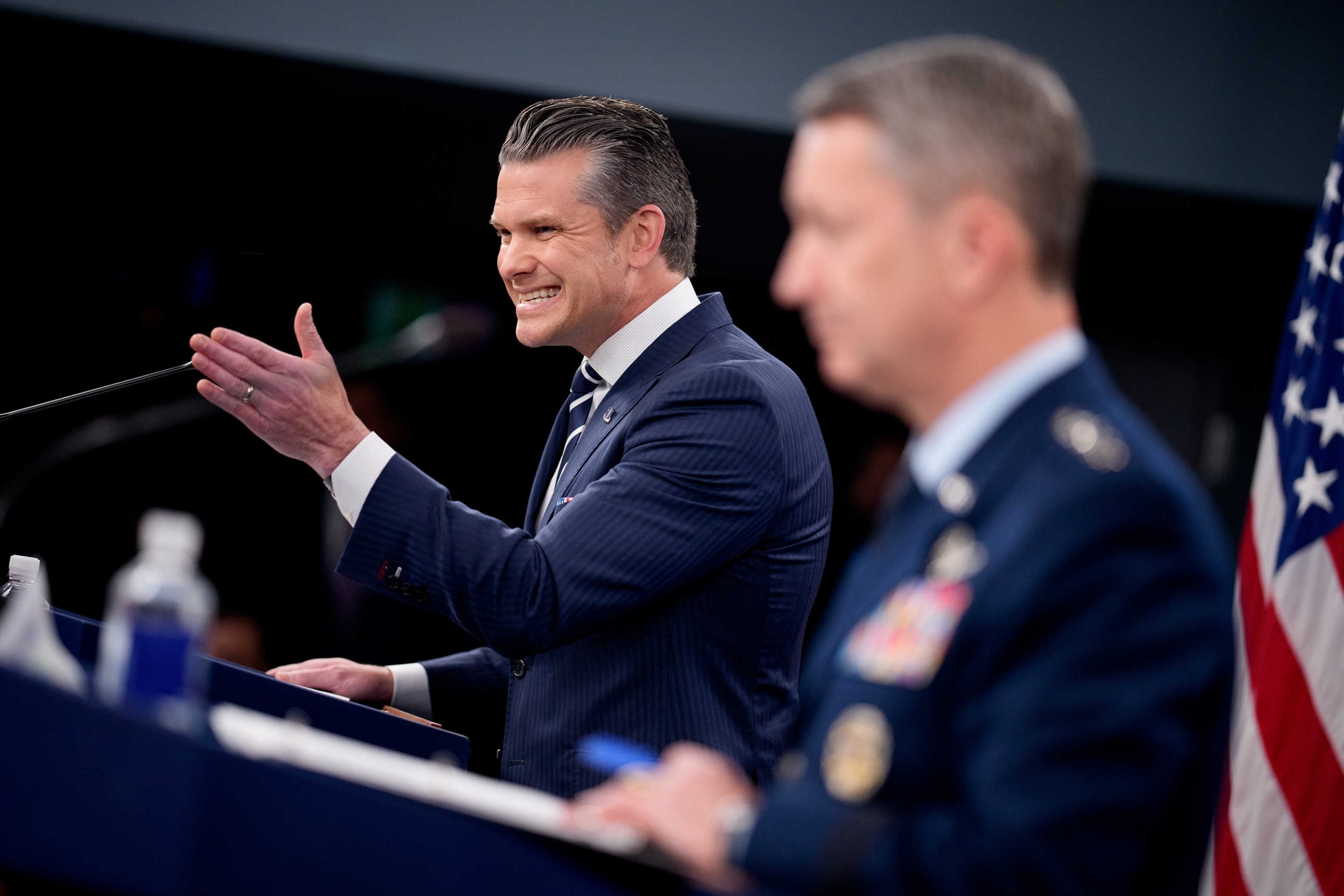The “Mednight Hammer Operation” with a basic code, the American precision attack of high secret against Iran nuclear facilities launched during the night was the largest strike using B2 bomber in history and was the longest flight that involved the fleet since 2001, Pentagon officials said on Sunday.
The mission included the first use of massive artillery penetrator pumps, or MOP, which had only been used previously in a test role, according to officials.
“Iran’s nuclear ambitions have been erased,” said the United States Secretary of Defense, Pete Hegseth, during a press conference from Sunday morning in the Pentagon, after the attacks.

The Secretary of Defense, Pete Hegesh, accompanied by the president of the Chief of Staff, the General of the Air Force, Dan Caine, speaks during a press conference at the Pentagon, on June 22, 2025 in Arlington, Virginia.
Andrew Harnik/Getty Images
More than 125 aircraft participated in the mission, including seven Spirit B-2 stealthy bombers that were launched from the continental United States shortly after the east time of midnight and resumed several times in the air while flying 18 hours to achieve their objectives, General Dan Caine, president of the personnel joints, during the press report. Other aircraft that participated in the mission included B-2 bombers used as lures, as well as fuel refueling, combat escorts and drones that provided intelligence, surveillance and acquisition of objectives, according to US officials.
Caine said that just after 2 in Iran’s time, B-2 bombers began launching 14 Mop on strike bombs in two of Iran’s nuclear facilities: Natanz and Fordo’s sites. Each Mop pump measures approximately 20 feet long, weighs 30,000 pounds and is able to penetrate 200 feet deep into a goal before exploiting.

The president of the staff of staff of Cabinet, the General of the Air Force, Dan Caine, analyzes the details of the mission of a strike over Iran during a press conference at the Pentagon, on June 22, 2025 in Arlington, Virginia.
Andrew Harnik/Getty Images
Caine called the “Operation Midnight Hammer” a “complex and high risk mission.”
According to Caine, a total of 13 B-2 bombers took almost at the same time on Saturday morning from Whiteman Air Force in Missouri. Six B-2 bombers were sent to Guam Pacific Island as lures, while the seven bombers used to point to the underground nuclear facilities of Iran in silence to direct the mission with little communication to avoid detection, Caine said.

The Secretary of Defense, Pete Heghseth, and the president of the Joints, Gen. Dan Caine, speak during a press conference at the Pentagon in Washington, on June 22, 2025
Alex Brandon/AP
Just before dropping their loads in Iran’s nuclear facilities, Caine said that two dozen Tomahawk cruise missiles were triggered to Isfahan’s nuclear site in Iran from an American submarine positioned in the region.
The Tomahawks were dismissed before the B-2 bombers carried out their air attacks, Caine said. However, due to their slower flight times and the distance they had to travel, the Tomahawk missiles did not achieve their objectives in Isfahan until shortly after the B-2 bombers had dropped their 14 bombs.
It was not clear immediately if the B-2 bombers sent to Guam once landed there. The 13 bombers are expected to return to the Whiteman Air Force base at dawn on Sunday afternoon, according to officials.
After the attack, President Donald Trump went to the White House Nation with Vice President JD Vance, Hegseth and Secretary of State Marco Rubio who stopped him behind him.
“Recently, the United States Army carried out massive precision attacks on the three key nuclear facilities in the Iranian regime: Forddo, Natanz and Isfahan. Everyone listened to those names for years while built this horribly destructive company of the horror sponsor of the destruction of Iran, and a stop to the nuclear threat raised by the number of horror sponsor of Iran.
The president added: “Tonight, I can inform the world that strikes were a spectacular military success. The key nuclear enrichment facilities of Iran have been completely erased.”

This satellite image provided by Maxar Technologies shows a closer view of craters and ashes on a crest at the Fordo enrichment center in Iran after the US strikes. UU. On June 22, 2025.
Satellite image 2025 Maxar Technologies
During the Sunday press session on Sunday, Hegseth said: “No other country on planet Earth could have achieved the operation”, echoing a statement that Trump had published on his social platform of truth after the attack.
“This is a plan that took months and weeks of positioning and preparation so that we could be ready when the president of the United States called,” Hegseth said. “It took great precision.” It involved the evil direction and the greatest operational security. “
Caine said there are no Iranian troops or civil structures were attacked and that throughout the mission, “we kept the surprise element.” He said that “very few people in Washington” knew the moment and nature of the plan and that Congress leaders were not informed until the mission was underway.
Hegseth said that B-2 bombers, each with a team of two people, reached the objectives of the nuclear installation and beaten them without being detected by the Iranian forces, saying that the stealthy plane entered “inside and outside and the back without the world knowing at all.”
Iran did not display his fighter or superficial missiles during the mission, Caine said.

A table that was exhibited during a press conference by Defense Secretary Pete Hegseth and the president of the General Chiefs of the Government, Dan Caine, in the Pentagon in Washington, on June 22, 2025.
Department of Defense through AP
Before the mission, the Israeli forces had spent about 10 days paralyzing Iran’s air defense capabilities, destroying much of their combat planes and leaving the military airfields in the country severely damaged.
While Hegesh and the White House promoted the mission as a great success, an evaluation is being evaluated to determine the scope of the damage to the nuclear facilities, Caine said during the informative session of Sunday morning.
“The evaluation of battle damage is ongoing, but our initial evaluation, as the president said, is that all our precision ammunition attacked where we wanted them to attacked and had the desired effect, which means that, especially the main objective here, we believe that we achieve the destruction of the capabilities there,” said Hegseth.
Hegesh emphasized that the purpose of the mission was to prevent them from developing a nuclear bomb, an objective that, according to the White House, the country was just a few days after achieving.
Hegseth also said that the mission was not aimed at a regime change in Iran. He said that public and private messages are delivered directly to the Iranians through multiple channels, “giving them every opportunity to come to the table” and negotiate a peace agreement.

This satellite image provided by Maxar Technologies shows new damage of extensive buildings in the ISFAHAN facilities in Iran after US attacks on June 22, 2025.
Satellite image 2025 Maxar Technologies
“They understand precisely what the US position is, precisely what steps can take to allow peace, and we hope they do it,” Hegseth said.
Hegesh said that while “anything can happen in conflict,” the operation is not open: “We recognize that but the reach of this was intentionally limited,” he said.
According to Caine, the troops in the region did not receive an early warning of the attacks. Following the strike, General Michael Erik Kurilla, commander of the United States Central Command (Centcom), supervising military operations in the Middle East and Central Asia, high measures of force protection throughout the region, especially in Iraq, Syria and the Gulf, Caine said.
“Our forces remain on a maximum alert and are completely positioned to respond to any Iranian retaliation or representation attacks, which would be an incredibly poor choice,” Caine said. “We will defend ourselves. The safety of the members and civilians of our service remains our top priority.”
This is a development story. Consult the updates again.

